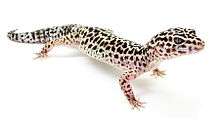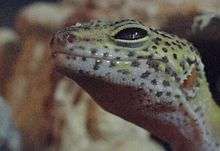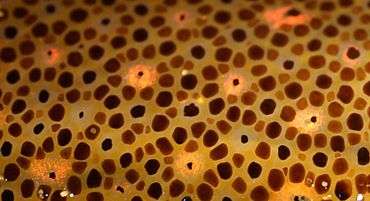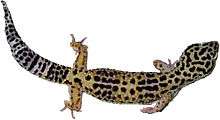Common leopard gecko
The common leopard gecko (Eublepharis macularius) is a cathemeral, ground-dwelling lizard native to the rocky dry grassland and desert regions of Afghanistan, Pakistan, north-west India, and Iran. The common leopard gecko has become a popular pet, and due to extensive captive breeding is sometimes referred to as the first domesticated species of lizard.
| Common leopard gecko | |
|---|---|
 | |
| Scientific classification | |
| Kingdom: | Animalia |
| Phylum: | Chordata |
| Class: | Reptilia |
| Order: | Squamata |
| Family: | Eublepharidae |
| Genus: | Eublepharis |
| Species: | E. macularius |
| Binomial name | |
| Eublepharis macularius (Blyth, 1854) | |
 | |
| Synonyms | |
| |
Taxonomy
Common leopard geckos were first described as a species by zoologist Edward Blyth in 1854 as Eublepharis macularius.[1] The generic name Eublepharis is a combination of the Greek words eu (good) and blepharos (eyelid), as having eyelids is the primary characteristic that distinguishes members of this subfamily from other geckos, along with a lack of lamellae, bumpy skin, and crepuscular behavior, though they may be found awake during the day occasionally.[2] The specific name macularius derives from the Latin word macula meaning "spot" or "blemish", referring to the animal's natural spotted markings. Common leopard geckos are related to many different geckos, such as the African fat-tailed gecko and the banded geckos. There are four other species within the Genus Eublepharis, leopard gecko, one of which was previously included as a subspecies of leopard gecko: In addition, there are five species in the genus.
Distribution and Habitat
The native habitat of the common leopard gecko is the rocky, dry grassland and desert regions of south-Asian Afghanistan, Pakistan, north-west India, and some parts of Iran[3][4]. Leopard geckos inhabit arid and semi-arid areas with sparse vegetation and clay or sandy soils, as well as rocky habitat where crevices can be used as shelter.[3] They reportedly avoid areas where the primary substrate is sand.[5]
Behavior and Ecology
Leopard geckos are cathemeral reptiles; in the wild they are mostly limited to burrows and shaded areas during the day, becoming more active at dawn and dusk when the temperature is favorable, and are often active quite sporadically in captivity.[6] Winter temperatures within the range of the leopard gecko can be quite low, below 10 °C (50 °F), forcing the animals underground into semi-hibernation, called brumation, living on fat reserves.
There is some debate as to the degree that leopard geckos interact with conspecifics in the wild. Academic sources have asserted that leopard geckos live in loose colonies in the wild. [5][4] Pet keeping guides often claim these geckos are solitary and do not usually live with other animals.[7][3] Acknowledging the latter as a myth propagated by pet keepers, Philippe de Vosjoli - a prominent leopard gecko breeder and author of dozens of books on reptile husbandry - has asserted that "The claims of some internet 'experts' that leopard geckos in the wild live singly... is not supported by facts." [3]
Diet
Leopard geckos are opportunistic predators that eat a variety of prey items. Invertebrates are presumed to make up the majority of wild geckos' diets, but in captivity they will also eat small vertebrate prey if given the opportunity, including baby "pink" mice and even hatchling leopard geckos[3]. Interestingly, breeders of captive leopard geckos report that sufficiently fed leopard geckos will not cannibalize young, and that the cannibalistic behavior appears to take place only in poorly fed animals[3].
Characteristics

Leopard geckos are small lizards that derive their name from their spotted coloration. Hatchlings are on average 7 to 10 cm (2.8 to 3.9 in) in length and weigh about 2 to 5 grams. Adult females are about 18 to 20 cm (7.1 to 7.9 in) in length and weigh about 50 to 70 grams, while adult male geckos are about 20 to 28 cm (7.9 to 11.0 in) in length and weigh about 60 to 80 grams.[8]
Due to extensive captive breeding and artificial selection, captive animals display a range of colors and patterns. Those found in the wild typically have more dull colorations than those kept in captivity as pets.
Unlike many other geckos, but like other Eublepharids, their toes do not have adhesive lamellae, so they cannot climb smooth vertical walls.
Teeth
Common leopard geckos are polyphyodonts and able to replace each of their 100 teeth every 3 to 4 months.[9] Next to the full grown tooth there is a small replacement tooth developing from the odontogenic stem cell in the dental lamina.[10]
Tails
Like most geckos, common leopard geckos' thick tails can regenerate when lost; however, the regenerated tails appear stumpy and never have the same appearance as the original tail.[7]
Chromatophores and color pigmentation

Common leopard geckos range in color from a yellow to brownish-orange base with spots covering all or mostly half of the dorsal region of the body. Their color is derived from pigment-containing cells known as chromatophores. These cells are responsible for an array of coloration seen in all reptiles, amphibians, birds and some species of insects. Chromatophores come in a variety of types based on the color they correspond to. Chromatophore types include xanthophores (responsible for yellow coloration), erythrophores (responsible for red coloration), iridophores (responsible for iridescence), leucophores (responsible for white coloration), melanophores (responsible for black coloration), and cyanophores (responsible for blue coloration). The skin of wild common leopard geckos contains xanthophores (yellow) and melanophores (black spots). Designer common leopard geckos may possess erythrophores and leucophores since commercial breeding and artificial selection have allowed novel coloration to arise.
Defense mechanisms
Common leopard geckos have predators such as snakes, foxes, and other large reptiles. Their keen sense of hearing and sight help them escape from them during the night. Along with their exceptional sight and hearing abilities, their skin helps camouflage themselves from their predators. Their sense of taste and smell also helps them with survival. They also stay in underground holes and burrows during the daytime, not only to avoid the heat but to also avoid the risk of getting eaten.[7]
Common leopard geckos also have the ability to voluntarily detach their tails if it is attacked, grabbed by the tail, bitten during copulation, or nipped by another during feeding. This is called caudal autotomy. After autotomy the tail can continue to twitch for as long as 30 minutes, allowing the gecko to escape from its predator.[11][12] The tail is large and at least in one related species (Christinus marmoratus) it has been reported that the tail-less fleeing gecko makes for a quicker getaway.[13] Fractures in the tailbone allow the tail to separate easily and rapid vasoconstriction allows the gecko to suffer minimal blood loss. This detaching of the tail causes a high level of stress on the gecko due to the loss of the valuable storage of fat it once had.[14] It will start to regenerate its tail immediately because it is needed for survival. A lost tail may increase the chance of sickness in the gecko and in some cases kill it, but this is very rare.[7] Regenerated tails often retain similar colors to the original tail [though there will most likely be a wide variance from the vibrancy and patterns of the original], however, they are often smooth and lack the rigid qualities and length of a normal tail. The tail will also be shorter and often fatter than the previous tail.
Sexual dimorphism

Sexual dimorphism is defined as a phenotypic difference between males and females of a species. It can be commonly found in animals, such as the common leopard gecko and other reptiles.[15] It exists in adult males and females, but can be difficult to determine in young geckos. The underside of a gecko truly determines the sex of the gecko. Males have pre-anal pores and hemipenal bulges while females have smaller pores and do not have external bulges.[7]
Males can determine the sex of other common leopard geckos by smelling pheromones on their skin. Males respond to males with aggressive behavior while they demonstrate courtship behavior towards females. Towards other males, the male would raise itself up from the ground, extend his limbs, and arch his back with the swelling of the tongue in aggression. He will then make short dashes and quick, vigorous bites, which frequently lacerate the skin and sometimes severely injure his opponent. Males behave the same way towards females while they are shedding their skin. Before and after the shedding of the skin, the males still express courtship behavior towards the females.[16]
Reproduction
Common leopard geckos are also known to have temperature-dependent sex determination (TSD). Research shows that more females can be produced in predominantly cool temperatures (about 26–29 °C [79–84 °F]) and very warm temperatures (about 34–35 °C [93–95 °F]). It was recorded that males can be produced at the intermediate temperatures (about 31–33 °C [88–91 °F]). Any temperature above that is normally not going to produce a newborn, as it will be too hot for the gecko inside the egg. Determination of sex is believed to be set during the first two weeks of incubation. The average amount of time it takes for a newborn to hatch is anywhere between 35 and 89 days, although it is usually closer to the latter.[17] Females born in the higher temperatures differed from those who were born in the lower temperatures hormonally and behaviorally. Those born in the warmer temperatures expressed more aggressive behavior.[18] These are known as "hot females" and are often determined to be infertile.
Common leopard geckos will breed typically in the summer. Females can store sperm over the course of their breeding season, so they can produce up to three clutches from one or two copulations, therefore, the male is not needed for reproductive success after the first or second copulation.[19] Once the female has mated and received sperm, she will need an abundance of calcium for health and to ensure that the eggs calcify properly. She can lay about six to eight clutches, which consists of two eggs in each clutch. They will normally lay two eggs approximately 21 to 28 days after mating. After 45 to 60 days, droplets of moisture will appear on the shell and the shell will begin to shrink and partially collapse. These are indications that the eggs will hatch. Baby common leopard geckos will have an "egg tooth", a calcareous tip at the end of its snout to help break their egg shell. Their "egg tooth" will fall off within one to two days. In addition to this, their skin will usually shed within 24 hours of hatching. The leopard gecko hatchling will not be able to eat until after the first shedding.[7]
Leopard geckos as a pet
Common leopard geckos are one of the most popular lizard pets. They are possibly the first domesticated lizard species.[20][21] Their small size, robustness, and relatively easy care makes them a good "beginner" reptile pet.[22] They breed easily in captivity, so most sold today are captive-bred rather than wild-caught.[23]:68–69[24][25]
They are well kept as pets, classified as a trait of its gentle nature, Leopard Geckos rarely bite; when they bite, it is usually painless. [23]:68
Leopard geckos should be fed with insects, such as crickets and mealworms, as they are insectivores.
See also
References
- Pockman, R. (1976). "1854. Proceedings of the Society. Report of the Curator, Zoological Department". Saurologica (2): 1–15.
- "Archived copy". Archived from the original on 6 January 2014. Retrieved 5 January 2014.CS1 maint: archived copy as title (link)
- De Vosjoli, Philippe. (2005). The herpetoculture of leopard geckos : twenty-seven generations of living art. Tremper, Ron., Klingenberg, Roger J., 1954-. [Place of publication not identified]: Advanced Visions. ISBN 0-9742971-2-7. OCLC 61484909.
- "(PDF) leopard gecko Eublepharis macularious from Pakistan". ResearchGate. Retrieved 29 June 2020.
- Minton A, Sherman (1966). "A contribution to the herpetology of West Pakistan". Bulletin of the AMNH. v. 134, (article 2): 72. Retrieved 6/28/2020. Check date values in:
|accessdate=(help)CS1 maint: extra punctuation (link) - Courteney-Smith, John (June 2012). "Lighting for a mixed leopard gecko colony" (PDF). Practical Reptile Keeping: 32–33. Archived from the original (PDF) on 2 April 2015. Retrieved 2 March 2013.
- Hamper, R. (2004). The Leopard Gecko, Eublepharis macularius, in Captivity. MI: ECO Herpetological Publishing & Distribution. ISBN 0971319782.
- "Leopard Gecko Information & Facts". thebeardeddragon.org.
- "Mechanism of tooth replacement in Leopard geckos". Archived from the original on 12 March 2015. Retrieved 4 November 2013.
- Identification of putative dental epithelial stem cells in a lizard with lifelong tooth replacement
- "Ta-da!". Audubon Magazine. Archived from the original on 13 July 2013. Retrieved 15 April 2013.
- Higham, T. E.; Russell, A. P. (2009). "Flip, flop and fly: Modulated motor control and highly variable movement patterns of autotomized gecko tails". Biology Letters. 6 (1): 70–73. doi:10.1098/rsbl.2009.0577. PMC 2817253. PMID 19740891.
- Daniels, Christopher B. (1983). "Running: an escape strategy enhanced by autotomy". Herpetologica. 39 (2): 162–165. JSTOR 3892556.
- Smith, Pauline (2004). "Leopard Gecko Care Sheet". The Gecko Spot. Archived from the original on 19 July 2019. Retrieved 15 April 2013.
- Kratochvil, L.; Frynta, D. (2002). "Body Size, Male Combat and the Evolution of Sexual Dimorphism in Eublepharid Geckos (Squamata: Eublepharidae)". Biological Journal of the Linnean Society. 76 (2): 303–314. doi:10.1046/j.1095-8312.2002.00064.x.
- Mason, R.T.; Gutzke, W.H.N. (1990). "Sex Recognition in the Leopard Gecko, Eublepharis macularius (Sauria: Gekkonidae) Possible Mediation by Skin-Derived Semiochemicals". Journal of Chemical Ecology. 16 (1): 27–36. doi:10.1007/BF01021265. PMID 24264893.
- "Leopard Gecko Breeding". www.reptilesmagazine.com. Retrieved 6 February 2019.
- Viets, B.E.; Tousignant, A.; Ewert, M.A.; Nelson, C.E.; Crews, D. (1993). "Temperature Dependent Sex Determination in the Leopard Gecko, Eublepharis macularius". The Journal of Experimental Zoology. 265 (6): 679–683. doi:10.1002/jez.1402650610. PMID 8487018. S2CID 23381743.
- LaDage, L.D.; Ferkin, M.H. (2008). "Do Conspecific Cues Affect Follicular Development in the Female Leopard Gecko (Eublepharis macularius)?". Behaviour. 145 (8): 1027–39. doi:10.1163/156853908784474506. S2CID 7678728.
- de Vosjoli, Philippe; Klingenberg, Roger; Tremper, Ron; Viets, Brian (2004). The Leopard Gecko Manual. BowTie, Inc. p. 5. ISBN 1-882770-62-5.
- Palika, Liz (2011). Leopard Geckos for Dummies. Wiley. ISBN 978-1-11806-827-4.
- McLeod, Lianne. "Geckos as Pets". about.com. Archived from the original on 4 March 2016. Retrieved 19 June 2012.
- Pavia, Audrey (4 December 1998). The Gecko: An Owner's Guide to a Happy Healthy Pet (1 ed.). Special Markets Department, Macmillan Publishing USA, 1633 Broadway, New York, NY 10019-6785: Macmillan Publishers Ltd. ISBN 9780876052129. Retrieved 9 January 2019.CS1 maint: location (link)
- Peacock, Hanna M; Gilbert, Emily A B; Vickaryous, Matthew K (November 2015). "Scar-free cutaneous wound healing in the leopard gecko, Eublepharis macularius". Journal of Anatomy. 227 (5): 596–610. doi:10.1111/joa.12368. ISSN 0021-8782. PMC 4609196. PMID 26360824.
- McDonald, Rebecca P.; Vickaryous, Matthew K. (25 June 2018). "Evidence for neurogenesis in the medial cortex of the leopard gecko, Eublepharis macularius". Scientific Reports. 8 (1): 9648. Bibcode:2018NatSR...8.9648M. doi:10.1038/s41598-018-27880-6. ISSN 2045-2322. PMC 6018638. PMID 29941970.
| Wikimedia Commons has media related to Eublepharis macularius. |
| Wikispecies has information related to Eublepharis macularius |
